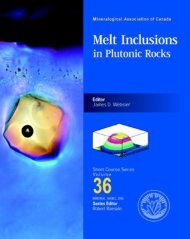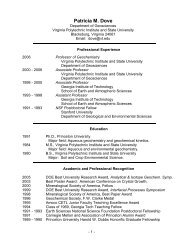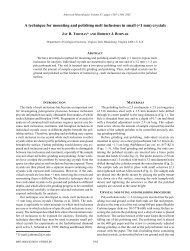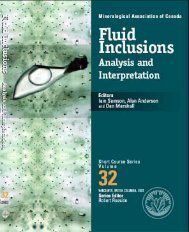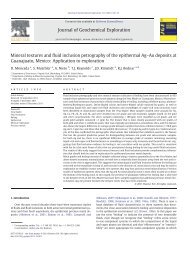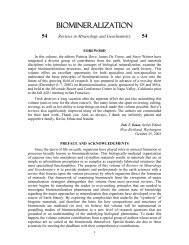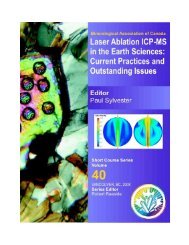Biomineralization Within Vesicles: The Calcite of Coccoliths
Biomineralization Within Vesicles: The Calcite of Coccoliths
Biomineralization Within Vesicles: The Calcite of Coccoliths
You also want an ePaper? Increase the reach of your titles
YUMPU automatically turns print PDFs into web optimized ePapers that Google loves.
<strong>Biomineralization</strong> <strong>Within</strong> <strong>Vesicles</strong> 191Figure 1. Coccolithophore life cycles. Diagram at top summarizes the basic life cycle <strong>of</strong> coccolithophores.Both diploid and haploid phases are chloroplast-bearing and can reproduce indefinitely by asexual binaryfission. Both phases can calcify producing heterococcoliths and holococcoliths, respectively, as illustratedhere by coccospheres <strong>of</strong> the two phases <strong>of</strong> Calcidiscus leptoporus ssp. quadriperforatus. Combinationcoccospheres with both coccolith types occur very rarely recording the life cycle transition, as shown by thecentre SEM and enlarged view.
<strong>Biomineralization</strong> <strong>Within</strong> <strong>Vesicles</strong> 193Figure 2. Coccolithogenesis in Pleurochrysis carterae. Schematic section, based on TEM images,through a coccolithophore showing coccolith formation within Golgi-derived vesicles. Reproduced withpermission from van der Wal et al. 1983.cisternae, derived from the Golgi body. <strong>The</strong> process commences with formation <strong>of</strong> anorganic scale. <strong>The</strong>se scales have a distinctive micr<strong>of</strong>ibrillar ultrastructure that ischaracteristic <strong>of</strong> scales in the haptophytes, and homologous non-calcified scales occur inmost non-coccolithophorid haptophytes (e.g., Billard 1994). In some cases, the scales areexocytosed without further development, to form an inner layer <strong>of</strong> body scales. In others,the vesicle develops a rather complex form, with extensions containing dense particlestermed coccolithosomes. Nucleation <strong>of</strong> calcite then occurs around the periphery <strong>of</strong> thebase-plate scale followed by crystal growth upward and outward to form the completecoccolith. During coccolith growth, the vesicle gradually expands, remaining in ratherclose contact with the developing coccolith. After completion <strong>of</strong> the coccolith, the vesicledilates and at this stage, a dense organic coating is visible around and between thecoccolith crystals. Exocytosis then occurs, apparently by fusion <strong>of</strong> the vesicle membraneand cell membrane. In this species the coccolithosomes appear to play a key role in
194 Young & Henriksencalcification and have been shown to be complexes <strong>of</strong> acidic polysaccharides withcalcium ions (Marsh 1994). It is thought that they function as calcium vectors duringbiomineralization and that the polysaccharide phase forms the crystal coatings.Detailed cytological observations on heterococcolith formation have also been madeon Emiliania huxleyi (e.g., Wilbur and Watabe 1963; Klaveness 1976; van der Wal et al.1983b, van Emburg et al 1986), while for a few other species there are isolated usefulstudies, including notably: Manton and Leedale (1969) − Coccolithus pelagicus; Inouyeand Pienaar (1984) − Umbilicosphaera sibogae; Inouye and Pienaar (1988) −Syracosphaera pulchra. <strong>The</strong>re is significant diversity in these observations, for instancecoccolithosomes are only known in Pleurochrysis, and in E. huxleyi the base-plate scaleis a very nebulous structure. Also in E. huxleyi calcification occurs in the “reticularbody,” an organelle that is separated from the Golgi body, but is thought to be derivedfrom it. Nonetheless, a clear overall pattern is similar in all cases, with calcificationoccurring in Golgi-derived vesicles and commencing with nucleation <strong>of</strong> a proto-coccolithring <strong>of</strong> simple crystals around the rim <strong>of</strong> a precursor base-plate scale, followed by growth<strong>of</strong> these crystals in various directions to form complex crystal units.Biochemical aspects: organic molecules involved in coccolith biomineralization<strong>The</strong> control by organisms on mineral expression is to a large extent attributed to theinfluence <strong>of</strong> organic molecules on nucleation and growth. Organic matrix frameworkscan provide binding sites for the components <strong>of</strong> a mineral, selectively nucleating specificcrystallographic faces, and organic carrier molecules can ensure supersaturation <strong>of</strong> aphase within mineralizing compartments. On a larger scale, shape regulation <strong>of</strong> suchcompartments can direct the morphology <strong>of</strong> biominerals forming within them (Mann1993). In the case <strong>of</strong> coccoliths, the primary organic molecules involved are complexacidic polysaccharides (Fichtinger-Schepman et al. 1981; Marsh et al. 1992; Marsh 1994;Ozaki et al. 2001; Marsh et al. 2002).<strong>The</strong> coccolith-associated polysaccharides (CAPs) <strong>of</strong> two species have been isolatedand analyzed. In Emiliania huxleyi, one polysaccharide has been located, having abackbone <strong>of</strong> mannose with many complex sidechains <strong>of</strong> galacturonic acid as well asester-bound sulphate groups (Fichtinger-Schepman et al. 1981). In the case <strong>of</strong>Pleurochrysis carterae, the situation is more complex, with 3 types <strong>of</strong> polysaccharidepresent (PS1, PS2, PS3; Marsh et al. 2002). PS1 and PS2 bind calcium and formcoccolithosomes, with PS2 probably playing an important role in the nucleation <strong>of</strong> theproto-coccolith ring, as evidenced by mutant P. carterae cells deficient in thispolysaccharide showing very little calcification (Marsh and Dickinson 1997). Duringcoccolith growth, PS3 is located between the crystals and the vesicle, and its function isbelieved to be shape regulatory, because P. carterae cells not expressing PS3 produce aproto-coccolith ring that does not develop further (Marsh et al. 2002). It is likely thatsimilar polysaccharides are active in other species <strong>of</strong> coccolithophore, instrumental inproducing their elaborately complex coccoliths.<strong>The</strong> active role inferred from this work for polysaccharides is unusual, since in mostbiomineralizing systems proteins are the key functional molecules. Proteins are alsoattractive targets for research since they are synthesized by RNA, allowing a range <strong>of</strong>genomic techniques to be applied to protein studies. However, despite extensive research,there has been only limited success to date in isolating and characterizing proteinsassociated with coccolith formation (Corstjens et al. 1998). This apparent anomaly is lesssurprising from an ecological perspective. Coccolithophores are photosynthetic algae,and a prime constraint on algal abundance in most oceanic environments is availability <strong>of</strong>nutrient elements for biosynthesis, especially N and P (e.g., Brand 1994). Sequestration
<strong>Biomineralization</strong> <strong>Within</strong> <strong>Vesicles</strong> 197Figure 4. Coccolithus pelagicus structure details. (A) Complete coccosphere. (B) Light micrographs <strong>of</strong>isolated coccoliths in phase contrast (top) and cross-polarized light (bottom), only the proximal shield isbirefringent in this orientation and so the specimen appears smaller than it does in phase contrast. (C)Complete coccolith in proximal view. (D) Oblique proximal view <strong>of</strong> broken coccolith. (E) Detail <strong>of</strong> D, withproto-coccolith ring locus visible. (F) Detail <strong>of</strong> proximal shield from a broken and slightly etched specimenshowing the two layers in this structure (compare with crystal unit diagrams).
198 Young & HenriksenFigure 5. Coccolithus pelagicus and Oolithotus fragilis atomic force microscopy images. (A) AFM image<strong>of</strong> a complete C. pelagicus coccolith. Compare with Figure 4C, oblique stripes extending beyond thecoccolith edge are tip artifacts. (B) Ultra high resolution AFM image from a large distal shield element,showing atomic pattern and demonstrating that rhombic faces are developed. A surface unit cell is shown,dashed line gives direction <strong>of</strong> atomic rows. (C−D) AFM images <strong>of</strong> complete O. fragilis coccolith and highresolution image from outer edge <strong>of</strong> coccolith showing atomic pattern and demonstrating that rhombicfaces are developed. (E) Interpretation <strong>of</strong> relationship <strong>of</strong> faces developed on C. pelagicus distal shieldelements (grey) to calcite rhomb. N.B. <strong>The</strong> element represented corresponds to those at bottom left <strong>of</strong> thespecimen in A. (F) Interpretation <strong>of</strong> relationship <strong>of</strong> faces developed on O. fragilis distal shield elements(grey) to calcite rhomb; N.B. <strong>The</strong> element represented corresponds to those at bottom centre <strong>of</strong> thespecimen in A, the pale grey portion <strong>of</strong> the element is a stepped surface. (B) and (D) have been correctedfor distortion following the method in Henriksen et al 2002.
<strong>Biomineralization</strong> <strong>Within</strong> <strong>Vesicles</strong> 199Figure 6. Coccolith structure in representative genera. (A) Emiliania huxleyi, diagram <strong>of</strong> crystal units;cross-polarized light micrograph <strong>of</strong> a coccolith (N.B. this micrograph is <strong>of</strong> Pseudoemiliania lacunosa aclosely related fossil species with larger coccoliths); SEM <strong>of</strong> isolated coccolith in distal view. (B) Biscutummagnum, a fossil species from the Late Cretaceous: diagram <strong>of</strong> crystal units, cross-polarized lightmicrograph, and SEMs <strong>of</strong> distal and proximal surfaces. (C) Ophiaster hydroideus, an extant species from aplankton sample: diagram <strong>of</strong> crystal units and SEM <strong>of</strong> partially disintegrated coccolith. All scale bars onemicrometer, double headed arrow symbols indicate orientation <strong>of</strong> calcite c-axis.
200 Young & Henriksen<strong>The</strong> Coccolithus structure is similar, but more complex—the V-unit again forms thedistal shield but also extends onto the proximal surface as a lower tube element. <strong>The</strong> R-unit forms the proximal shield, but extends on the distal surface as an upper tube element(Fig. 3A-B). As a result, the two crystal unit types are intergrown and the proto-coccolithring is embedded within the coccolith structure and only visible on broken specimens(Fig. 4D-E). Additional complexity is seen on the proximal shield with development <strong>of</strong>separate upper and lower elements growing at different angles. <strong>The</strong> upper unit isapproximately radially directed (and elongate approximately parallel to the c-axis), whilethe lower element is oblique to this (Fig. 4F). Finally on complete coccoliths, the centralarea elements on both the proximal and distal surfaces appear to be composed <strong>of</strong> a mass<strong>of</strong> minute elements, but interconnections between them are <strong>of</strong>ten visible, and atintermediate growth phases the morphology is simpler; hence these are evidently aproduct <strong>of</strong> less regular growth at a late phase.<strong>The</strong> Emiliania structure (Westbroek et al. 1989; Young 1989; Didymus et al. 1994) isunusual in being composed essentially <strong>of</strong> R-units, with the V-units confined to the protococcolithring (Fig. 6A). As a result, the individual R-units have particularly complex form,being constructed <strong>of</strong> proximal shield, distal shield, inner tube and central area elements,each <strong>of</strong> which represents a separate growth direction from the nucleation site.Ophiaster has a simple rim <strong>of</strong> alternating V- and R-units but the central area isfloored by separate elements. <strong>The</strong>se elements interdigitate with the rim units, but arecrystallographically separate and have sub-tangential c-axis orientations. This structurewith three separate crystal unit types has been described in detail for Syracosphaerapulchra (Young et al. in press).Nucleation<strong>The</strong> most remarkable common feature <strong>of</strong> the heterococcoliths is the development <strong>of</strong>the rim from a proto-coccolith ring <strong>of</strong> simple calcite crystals with alternating sub-verticaland sub-radial c-axis orientations—the V/R structure <strong>of</strong> Young et al. (1992). This isshown by each <strong>of</strong> the illustrated examples and has been demonstrated in numerous others(e.g., Young and Bown 1997; Marsh 1999; Young et al. 1999). In some cases, it has onlybeen possible to demonstrate that the rim consists <strong>of</strong> two alternating crystal unit types,not to prove that these have different c-axis orientations. For instance, in thePapposphaeraceae the rim is clearly formed from two alternating crystal unit types (e.g.,Manton and Oates 1975), but because the entire coccoliths are usually only 1-2 micronslong and specimens are rare, it has not been possible for crystallographic orientations tobe determined. However, it seems reasonable to predict that these fit the basic V/Rmodel. This means that the first stage <strong>of</strong> biomineralization is nucleation <strong>of</strong> a ring <strong>of</strong>calcite nuclei with alternating orientations. This is a distinctive feature <strong>of</strong>heterococcoliths with no obvious parallels in any other biomineralization systems and hasdemonstrably remained constant through more than 200 million years <strong>of</strong> coccolithevolution (Young et al. 1992, 1999). Moreover, nucleation controls total calciteorientation, i.e., not simply c-axis orientation, but also a-axis orientation. This isevidenced by the fact that crystal faces on adjacent elements are sub-parallel (e.g., Fig. 1,3C−G, 5A). It has also been demonstrated using SAED study <strong>of</strong> Emiliania huxleyicoccoliths (Davis et al. 1995) and AFM study <strong>of</strong> Coccolithus pelagicus and Oolithotusfragilis (Henriksen et al. in press a).A final distinctive, nucleation-related feature is that all heterococcoliths showchirality. This is seen for instance in element orientations and cross-polarized lightextinction crosses. <strong>The</strong> lower proximal shield elements <strong>of</strong> Coccolithus (Figs. 3A, 4F) area good example. <strong>The</strong>se grow at an oblique angle and always show clockwise <strong>of</strong>fset from
<strong>Biomineralization</strong> <strong>Within</strong> <strong>Vesicles</strong> 201the radial direction in proximal view. This chirality is related to departures <strong>of</strong> thenucleation orientations from simple orthogonal radial and vertical directions, i.e., thenucleation is chiral (Didymus et al 1994; Young et al. 1999).Thus, heterococcolith rim nucleation is characterized by a suite <strong>of</strong> features:alternation <strong>of</strong> c-axis orientations, control <strong>of</strong> a-axis orientations, stability throughevolutionary history and chirality. This very precise nucleation control can most easily beexplained in terms <strong>of</strong> control from a macromolecular template substrate. <strong>The</strong> principalalternative would be random nucleation followed by selection <strong>of</strong> favorably orientednuclei, but this should only lead to selection <strong>of</strong> c-axis directions, as is seen in many otherbiomineral systems, not total crystal orientation, which is much more rare. Similarly,chirality is a predictable result <strong>of</strong> nucleation on a biochemical substrate since virtually allorganic macromolecules are chiral and occur in natural systems as only oneenantiomorph. <strong>The</strong>refore, a plausible model for the precise nucleation control around themargin <strong>of</strong> the organic baseplate is that a belt <strong>of</strong> macromolecular substrate occurs in thisposition with arrays <strong>of</strong> potential binding sites for calcium or carbonate ions whichpromotes nucleation <strong>of</strong> oriented calcite crystallites. Young et al. (1992, 1999), and Marsh(1999) speculated on possible geometries <strong>of</strong> such a template that could result in the V/Rpattern <strong>of</strong> evolutionarily stable alternation <strong>of</strong> nucleation directions.This hypothesis is tempting, but it has not been substantiated by direct evidence.Furthermore, although all heterococcoliths appear to have rims conforming to the V/Rmodel, additional, separately-nucleated crystals that do not fit this model <strong>of</strong>ten occur inthe central area <strong>of</strong> heterococcoliths. Ophiaster illustrates one rather common pattern, seenin numerous coccoliths produced by the families Syracosphaeraceae andRhabdosphaeraceae (Young et al. in press), an apparent pattern <strong>of</strong> V/R/T alternation. Thiswould require a more complex template but could still conform to the general model.Such coccoliths, however, also <strong>of</strong>ten have additional elements separate from the rim.<strong>The</strong>re are a few such elements visible in Ophiaster (Fig. 6C). A more extreme and verybeautiful example is provided by Rhabdosphaera (Fig. 7). Here the rim, with inferredV/R structure, is very narrow and encloses a large mass <strong>of</strong> lamellar crystal units and acentral spine <strong>of</strong> intergrown crystals (Kleijne 1992). <strong>The</strong> spine structure is remarkablyelegant, consisting <strong>of</strong> five interwound spirals <strong>of</strong> crystals (Fig. 7C). <strong>The</strong> componentcrystals <strong>of</strong> the spine show regular rhombohedral faces with perfectly regular alignmentspiraling up the structure. Evidently, nucleation here is not confined to the narrow beltaround the baseplate but occurs across the base and up the spine, still with regular crystalalignment and consistent chirality. If a template is involved, it is unclear where it islocated and it lacks the V/R alternation.GrowthRegulation <strong>of</strong> calcite growth by coccolithophores is almost as remarkable as theregulation <strong>of</strong> nucleation. <strong>The</strong> crystal units sketched in Figures 3 and 6 are each singlecrystals <strong>of</strong> calcite, and their shapes are radically different from that <strong>of</strong> inorganic calcite.However, such crystals do not exist in isolation, but are parts <strong>of</strong> the complete coccolith, andmuch <strong>of</strong> the morphology is a product <strong>of</strong> interaction between adjacent crystals. Further, it isclear from the cytological observations that there is no precursor matrix for the coccolith,but rather that the coccolith grows in an expanding vesicle. <strong>The</strong> final structure <strong>of</strong> thecompleted coccoliths to a large extent an emergent result <strong>of</strong> inorganic growth <strong>of</strong> thecrystals defined by the nucleation stage, within a space defined by the expanding vesicle.Because inorganic growth directions are utilized, the precise orientation <strong>of</strong> the calcitecrystal lattice in coccolith elements is important for developing morphology. Using atomicforce microscopy, we have investigated C. pelagicus and O. fragilis coccoliths from
202 Young & HenriksenFigure 7. Rhabdosphaera clavigera. (A) Coccosphere. (B) Detail <strong>of</strong> base, showing the narrow rim, withV/R structure, surrounding a wide central area <strong>of</strong> separately nucleated lamellar elements, these haverhombic faces on their distal side and truncated surfaces on the proximal side. (C) A spine tip showing thespiral structure <strong>of</strong> spine formed from consistently aligned crystal units with rhombic faces. N.B. <strong>The</strong>pentaradiate apical structure is consistently developed. Scale bars = 1 µm.
<strong>Biomineralization</strong> <strong>Within</strong> <strong>Vesicles</strong> 203micrometer to atomic scale and with these observations have established the preciserelationships between element morphology and crystal lattice (Fig. 5; Henriksen et al. inpress a). High resolution AFM <strong>of</strong> the flat surfaces <strong>of</strong> the elements (Fig. 5B and D) revealan atomic pattern identical to that known from rhombic {10¯14} faces <strong>of</strong> inorganic calcite(Stipp et al. 1994; Stipp 1999). It shows the characteristic surface unit cell, atomic rowsdefining the orientation <strong>of</strong> the a-axis vector, and a pairing <strong>of</strong> these rows that constrainsthe crystallographic orientation fully (Henriksen et al. in press a). C. pelagicus has{10¯14} faces on the whole distal shield surface and has element edges defined byrhombic cleavage (Fig. 5E), with individual elements stuck together by imbrication. Bycontrast, in O. fragilis the crystal lattice is rotated so that acute crystallographic cornersmake the complex element edges. This enables elements to interlock without overlap,allowing for very thin and delicate coccoliths (Fig. 5F). <strong>The</strong> outer part <strong>of</strong> the distal shieldconsists <strong>of</strong> rhombic faces that are broken by a series <strong>of</strong> steps forming the slope towardsthe middle, probably induced by constraints on growth space by the vesicle. Thus, in bothspecies the rhombic calcite motif is much in evidence, but detailed variations inorientation allow them to construct coccoliths with very different properties.An example <strong>of</strong> the importance <strong>of</strong> the interplay <strong>of</strong> rhombic growth directions withvesicle geometry is provided by comparing coccoliths <strong>of</strong> the closely related speciesCalcidiscus leptoporus, Umbilicosphaera foliosa and Umbilicosphaera sibogae (Fig. 8).<strong>The</strong>se belong to the family Calcidiscaceae and have their distal shields entirely formedfrom V-units (Young 1998; Young et al. in press). Calcidiscus leptoporus (Fig. 8A)shows flat, overlapping elements with curved radial edges. <strong>The</strong> surfaces are almostcertainly rhombic calcite faces, as can be seen from overgrown specimens, fromexamination <strong>of</strong> face relationships in the central area, and by analogy with the relatedspecies Coccolithus pelagicus and Oolithotus fragilis. Umbilicosphaera sibogae (Fig.8B) is similar, but has a wider central opening and radial edges showing a pronouncedkink. Umbilicosphaera foliosa (Fig. 8C) also has flat, probably rhombic faces, but hastwo cycles in the shield. <strong>The</strong> inner cycle is imbricated clockwise, the outer is imbricatedcounter-clockwise, with both cycles showing crystallographic edges. Superficially, this isa very complex crystal structure. However, when a large number <strong>of</strong> specimens isinvestigated at high resolution, paying close attention to overgrown and malformedexamples, it becomes evident that both shield cycles are made up <strong>of</strong> the same crystalunits. This is illustrated in Figure 9. <strong>The</strong> crystal units actually have a rather simple basicshape, as indicated by the dotted lines on Figure 9B, which also reflect the shape <strong>of</strong> theelements on the proximal surface. This simplicity is in marked contrast to the apparentcomplexity on the distal surface, caused by counter-clockwise growth on the surface <strong>of</strong>the crystal in the outer part <strong>of</strong> the coccolith and clockwise growth in the inner part. <strong>The</strong>difference in growth direction is in fact a predictable result <strong>of</strong> the plane <strong>of</strong> the crystalsurface intersecting obliquely with a conical surface (Fig. 9C). This is not seen in C.leptoporus since the elements are less obliquely oriented, and there are fewer <strong>of</strong> them.Figure 8D shows a specimen <strong>of</strong> U. foliosa with rather irregular growth that has thecomplete range <strong>of</strong> element types, from simple elements like those typical <strong>of</strong> C.leptoporus, through kinked elements like those <strong>of</strong> U. sibogae, to the <strong>of</strong>fset bicyclicelements typical <strong>of</strong> U. foliosa. <strong>The</strong> fact that all three can occur on one coccolith as aresult <strong>of</strong> malformation proves that no major changes in mechanism are necessary to formone rather than the other. Further, this suggests that the range <strong>of</strong> distal shield elementmorphologies seen in the three species arise as a product <strong>of</strong> interaction <strong>of</strong> crystalorientation and coccolith shape rather than through any direct control <strong>of</strong> crystal growth.This example is thought-provoking because it shows that in biomineralization, a trivialchange in process can result in a large morphological effect.
204 Young & HenriksenFigure 8. Growth pattern variations in Calcidiscus and Umbilicosphaera. <strong>Coccoliths</strong> <strong>of</strong> three closelyrelated species, in distal view. In each <strong>of</strong> these species the entire distal shield is formed <strong>of</strong> V-units, andthe visible surface are rhombic faces. (a) Calcidiscus leptoporus. (b) Umbilicosphaera sibogae. (c)well-formed Umbilicosphaera foliosa showing complex suture pattern and apparent division into twocycles <strong>of</strong> elements. (d) malformed U. foliosa showing a range <strong>of</strong> element morphologies from thosetypical <strong>of</strong> C. leptoporus to those typical <strong>of</strong> U. foliosa.<strong>The</strong> surfaces shown in Figures 8 and 9 are all characterized by growth across thesurface resulting in formation <strong>of</strong> inorganic rhombic crystal faces. <strong>The</strong>se are common,especially on distal surfaces and on central area structures (e.g., Rhabdosphaera, Fig. 7).Another class <strong>of</strong> surfaces also occurs, characterized by absence <strong>of</strong> growth on the surfaceand development <strong>of</strong> non-crystal surfaces (Henriksen et al. in press b; Young et al. in press).<strong>The</strong> distal shield <strong>of</strong> Coccolithus pelagicus shows examples <strong>of</strong> both surface types; growthoccurs incrementally on the upper surface, which develops as a rhombic face, while nogrowth occurs on the lower surface, which develops as a trailing surface behind the growthfront. Some coccoliths, e.g., Emiliania huxleyi, appear to be almost entirely characterizedby this surface type, with growth confined to narrow fronts at the tip <strong>of</strong> the element. Withthis type <strong>of</strong> growth it seems likely that crystal growth is blocked by organic coatings, mostlikely <strong>of</strong> coccolith-associated polysaccharides (Young et al. 1999). Such coatings arevisible on TEM sections after staining for polysaccharides (e.g., Outka and Williams 1971;Marsh 1994; Klaveness 1976; Young et al. 1999). We have been able to demonstratethrough AFM dissolution studies that these coatings do protect the completed crystals(Henriksen et al. in press b). It is reasonable to infer that a coating <strong>of</strong> polysaccharide thatcan prevent dissolution <strong>of</strong> an element would also serve to inhibit crystal growth. <strong>The</strong>refore,the difference between the two calcite surface types seen in coccoliths—rhombic calcite
<strong>Biomineralization</strong> <strong>Within</strong> <strong>Vesicles</strong> 205Figure 9. Complex element morphology from simple crystal growth. Side view <strong>of</strong> an Umbilicosphaerafoliosa coccolith (top), detail <strong>of</strong> distal shield (middle), and interpretative diagram (bottom). Numberingon the crystal units indicates the degree <strong>of</strong> <strong>of</strong>fset between the inner and outer cycles. <strong>The</strong> continuity <strong>of</strong>the crystal units between the cycles is directly visible on units 1 and 2 and is further indicated bydevelopment <strong>of</strong> parallel edges on the inner and outer cycles (lines on leading and trailing edges <strong>of</strong> units2 and 5). Dotted lines indicate summary trajectory <strong>of</strong> units 3 and 4; this is approximately the patternseen on the proximal surface <strong>of</strong> the distal shield. Diagram below: oblique section across the coccolithsurface illustrating how the differing senses <strong>of</strong> apparent imbrication in the inner and outer cycles can beproduced by a single set <strong>of</strong> crystal faces.faces and non-crystalline faces—may be a function <strong>of</strong> selective blocking bypolysaccharides. Nonetheless, is not clear why these two crystal surface types occur or howvesicles are able to block growth on some surfaces, but not others.HOLOCOCCOLITHSWhile heterococcoliths have been rather extensively studied, the alternativebiomineral form, holococcoliths (Fig. 10), formed in the haploid life cycle stage, hasreceived less attention and proven more enigmatic.
206 Young & HenriksenFigure 10. Holococcolith form. (A−C) Syracosphaera anthos holococcoliths (older name Periphyllophoramirabilis). (A) complete coccosphere; (B) detail <strong>of</strong> coccolith; (C) acid etched specimen (reproduced withpermission from Halldal and Markali (1955), showing organic coatings around the coccoliths. (D)Corisphaera sp. partially collapsed coccolith with similar wall fabric to that <strong>of</strong> S. anthos, showing that it isformed <strong>of</strong> rhombohedral crystallites. (E) Calyptrolithophora papillifera showing perforate hexagonalcrystallite arrangement. Again the constituent crystallites are rhombohedral. (F) Coccolithus pelagicusholococcoliths (older name Crystallolithus hyalinus), showing construction from rhombohedral crystallitesin rhombohedral assembly.
<strong>Biomineralization</strong> <strong>Within</strong> <strong>Vesicles</strong> 207Cytological observationsVery few holococcolithophore cultures have been maintained and only two specieshave been studied in cytological section. Coccolithus pelagicus was studied by Manton andLeedale (1963, 1969) and by Rowson et al. (1986) while Calyptrosphaera sphaeroidea wasstudied by Klaveness (1973). As with heterococcoliths these studies showed that theholococcoliths are underlain by organic base-plate scales and these scales could be seendeveloping in Golgi vesicles. However, despite numerous observations, no intracellularcalcification could be seen, nor have intracellular holococcoliths been seen in lightmicroscopy studies. Hence, it has been inferred that calcification occurs outside the cellmembrane, after exocytosis <strong>of</strong> the base-plate scale. This poses obvious problems forunderstanding how calcification is regulated. A partial solution is provided by observationsthat, in motile species, exocytosis <strong>of</strong> coccoliths and scales occurs at the flagellar pole, andthat, at least in the studied species, a delicate “skin” envelopes the coccosphere. <strong>The</strong>refore,even if calcification does occur outside the cell membrane, it is likely to occur in aprivileged and highly regulated environment. Alternatively, it is possible that calcificationoccurs just below the cell membrane but is a rapid process immediately precedingexocytosis and so has not been captured in cytological sections. Since holococcoliths instatu nascendi have not been observed, there is no evidence from cytology on the pattern <strong>of</strong>growth in holococcoliths.Biochemical observations<strong>The</strong>re have been no studies on the biochemistry <strong>of</strong> holococcolith biomineralization.This reflects the need for biochemical work to focus on a few case studies and the verysmall number <strong>of</strong> holococcolith cultures available for study. In addition, the two mostfrequently cultured coccolithophore species, Emiliania huxleyi and Pleurochrysiscarterae do not produce holococcoliths. <strong>The</strong> species have a similar haplo-diploid lifecycleto other coccolithophores, but the haploid phase cells do not calcify.Morphological observations<strong>The</strong> primary research carried out on holococcoliths is detailed study <strong>of</strong> morphologyin order to establish their taxonomy (e.g., Kleijne 1991, Cros et al. 2000, Cros andFortuño 2002). This has resulted in a rich archive <strong>of</strong> detailed morphological data. <strong>The</strong>primary data source is scanning electron microscopy; supplementary information comesfrom cross-polarized light microscopy, which has provided data on crystallographicorientation (Crudeli and Young 2003). Finally, invaluable observations <strong>of</strong> organiccoatings were made by early Norwegian researchers, notably Halldal and Markali (1955),who decalcified plankton samples using hydrochloric acid. This technique left the organiccoatings as ghost specimens. A representative image is included as Figure 10C. From thiswork several relevant observations can be made.1. Holococcolith shape is highly regulated. Separate species have unique and veryconsistent morphologies. In the case <strong>of</strong> Syracosphaera anthos holococcoliths,(Fig. 10A−C) consistent features in addition to the gross shape, include thepresence <strong>of</strong> a hole at the base <strong>of</strong> the leaf-like distal process and a double-layeredstructure to both the process and the main tube wall. In comparison toheterococcoliths, there is at least as much regulation <strong>of</strong> total coccolith shape.2. <strong>The</strong> entire structure is made up <strong>of</strong> minute equant crystallites. This is obvious as asurface texture, but also applies where holococcoliths form thick basal structures.In such cases, the fabric consists <strong>of</strong> numerous layers <strong>of</strong> separate crystallites,rather than elongated crystallites. Moreover, observations <strong>of</strong> disintegratingholococcoliths (e.g., Fig. 10D) suggest that crystallites are predominantly and
208 Young & Henriksenperhaps invariably, euhedral rhombohedra. <strong>The</strong> crystallites are <strong>of</strong>ten referred toas hexagonal, but this is more accurately a description <strong>of</strong> the arrangement <strong>of</strong> thecrystallites.3. <strong>The</strong> crystallites do not interlock or intergrow. This is very nicely shown by theacid etched specimens (Fig. 10C), but again observations on numerous otherspecimens show it is a general pattern.4. <strong>The</strong> crystallites are each enveloped in an organic coating. <strong>The</strong> best evidence forthis comes from the acid etched specimens. Presumably, this is similar to thepolysaccharide coatings <strong>of</strong> heterococcoliths. In SEM the holococcolithcrystallites <strong>of</strong>ten have rough surfaces rather than smooth crystal faces; this maybe due to these organic coatings.5. <strong>The</strong> crystal faces <strong>of</strong> the crystallites are clearly aligned across large areas <strong>of</strong> theholococcoliths; thus the crystallographic orientation <strong>of</strong> the crystallites iscompletely controlled.6. Although all holococcolith crystallites are broadly similar, there are consistentdifferences in crystallite size and surface morphology, both between species andoccasionally even over different parts <strong>of</strong> a single holococcolith. This is shown toa limited extent by the S. anthos holococcoliths, where there is a field <strong>of</strong> larger,less regular crystallites at the base <strong>of</strong> the tube. Note also that the crystallites <strong>of</strong> C.pelagicus holococcoliths (Fig. 10F) are significantly larger (~0.2 µm across) thanthose <strong>of</strong> the other figured species (which are ~0.1 µm across).7. Crystallite arrangement patterns are clearly controlled by the biomineral system,varying between species and between parts <strong>of</strong> single holococcoliths. <strong>The</strong> mostcommon arrangement is a hexagonal fabric (Figs. 10A−D), in which rhombohedralcrystallites are arranged edge to edge, with their c-axes directed perpendicular tothe surface. This may be modified into a hexagonal mesh fabric, in which one infour crystallites is missing, giving a sieve-like appearance (Fig. 10E). Other lessregular variations on this basic pattern occur. Rhombohedral array fabrics (Fig.10F) are distinctively different; the rhombohedra are arranged with the c-axesoblique to the surface, and the crystallites are aligned face to face.All these features tend to emphasize the basic observation that holococcolithbiomineralization is a remarkably highly regulated process with the final morphology aproduct <strong>of</strong> biologically controlled mineralization, even if it occurs outside the cellmembrane. <strong>The</strong>re is, however, still essentially no model for how the growth regulationoccurs. Crystallite growth does not show the remarkable sculpting <strong>of</strong> heterococcolithcrystal units, but the regular termination <strong>of</strong> growth such that each crystallite is <strong>of</strong> regularsize and shape is striking. This could be a product <strong>of</strong> biologically mediated growth;calcite rhombohedra <strong>of</strong> uniform size can be produced in vitro with surface inhibitors(Henriksen unpubl. data).Control <strong>of</strong> crystallite orientation is difficult to understand, since the dispersednucleation necessary to produce all the crystallites and the layered structure in somespecies makes it difficult to envisage how or where an organic template precursor couldoccur. An alternative that should be considered is that the crystallites are initiallyrandomly oriented and are aligned by the coccolith shaping system. It is even conceivablethat the crystallites are not formed in situ but are delivered preformed to the growingholococcolith.It is frustrating that biomineralization in holococcoliths is so poorly understood andthat it has not been possible to make any direct observations <strong>of</strong> the growth process, not
<strong>Biomineralization</strong> <strong>Within</strong> <strong>Vesicles</strong> 209least since this appears to be a rather flexible biomineralization mechanism capable <strong>of</strong>construction <strong>of</strong> elaborate structures from simple biomineral components. <strong>The</strong>refore, itmay prove a more useful model system than heterococcolith biomineralization forpotential applications in nan<strong>of</strong>abrication.THE EVOLUTION OF COCCOLITHOPHOREBIOMINERALIZATION MECHANISMSAs explained earlier, the haplo-diploid life cycles with holococcolith-heterococcolithalternation are common in coccolithophores and indeed occur in at least six <strong>of</strong> the 13described families. <strong>The</strong>se families span the phylogenetic diversity <strong>of</strong> coccolithophorids,as inferred from both the fossil record and molecular genetics (Young et al. 1999;Houdan et al. in press). Hence, it seems that holococcolith-heterococcolith differentiationmust be a primitive evolutionary feature, with an origin near in time to that <strong>of</strong>calcification in coccolithophores as a whole. This is also supported by the fact that fossilholococcoliths, although much rarer than fossil heterococcoliths, have a record whichextends back nearly as far through geological time. Definite holococcoliths are knownback to the Early Jurassic ca. 190 Ma while definite heterococcoliths occur back to LateTriassic, ca. 220 Ma (Bown 1993, 1998a,b). Given that both heterococcoliths andholococcoliths are elaborate biomineral structures with numerous unique features, theymust each have evolved only once. Hence, it is likely that biomineralization evolved firstin one life cycle phase, then transferred to the other, although, for some reason, only part<strong>of</strong> the process could be transferred.<strong>The</strong> occurrence <strong>of</strong> the heterococcoliths in the fossil record before that <strong>of</strong>holococcoliths provides weak evidence that they evolved first. This might be dismissedas a preservational artifact but it is supported by two other lines <strong>of</strong> evidence. First, all <strong>of</strong>the published molecular genetic analyses (Edvardsen et al. 2000; Fujiwara et al. 2001,Saez et al. in press) find the basal coccolithophore clade is comprised <strong>of</strong> the generaEmiliania and Gephyrocapsa (Family Noelaerhabdaceae). <strong>The</strong>se genera only calcify inthe diploid phase, so their basal position in the tree suggests that the absence <strong>of</strong>calcification in the haploid phase may be a primitive character. This cannot be taken asdefinite evidence however, since calcification is also absent in the haploid phase <strong>of</strong>Pleurochrysis and Hymenomonas, but these have a much higher position within thecoccolithophore clade and therefore must have lost holococcolith biomineralizationsecondarily. Second, two coccolithophore life cycles are now known in which aheterococcolith phase alternates with a nannolith-producing phase (Fig. 11), i.e., a phasethat produces calcareous structures which do not show the characteristic features <strong>of</strong> eitherholococcoliths or heterococcoliths (Young et al. 1999). <strong>The</strong>se examples are (1)Ceratolithus, in which a heterococcolith-producing phase alternates with a phaseproducing large horseshoe-shaped nannoliths (Alcober and Jordan 1997; Young et al.1998; Cros et al. 2000; Sprengel and Young 2000). (2) Alisphaera, in which aheterococcolith-producing phase (Fig. 11E) alternates with a phase producing minute,cup-shaped, aragonitic nannoliths (Fig. 11D−F), as evidenced by the occurrence <strong>of</strong>spectacular combination coccospheres (Cros and Fortuño 2002). <strong>The</strong>se nannoliths,formerly regarded as a discrete genus, “Polycrater”, show some similarities to normalheterococcoliths but are unique in being formed <strong>of</strong> aragonite (Manton and Oates 1980)rather than calcite. <strong>The</strong>y also lack the typical rim features <strong>of</strong> heterococcoliths;consequently Young et al. (1999) highlighted their anomalous structure and consideredthem likely candidates for additional biomineralization modes within thecoccolithophores. This prediction is strongly supported by the combination coccosphereevidence. Neither Ceratolithus nor Alisphaera have yet been isolated into culture so there
210 Young & HenriksenFigure 11. Nannoliths. Two examples <strong>of</strong> species with life cycles involving heterococcoliths and nannolithsrather than heterococcoliths and holococcoliths. (A−C) Ceratolithus cristatus: (A) collapsed combinationcoccosphere with heterococcoliths and ceratolith nannolith; (B) coccosphere <strong>of</strong> heterococcoliths; (C)isolated ceratolith. (D−F) Alisphaera: (D) isolated nannoliths, minute cup-shaped aragonitic liths (alsoknown as Polycrater galapagensis); (E) coccosphere <strong>of</strong> the heterococcolith phase; (F) coccosphere <strong>of</strong> thenannolith (“Polycrater”) phase.
<strong>Biomineralization</strong> <strong>Within</strong> <strong>Vesicles</strong> 211are no direct observations on ploidy level (relative genome size) in the two phases. Wehypothesize that, as in all studied cases to date, the heterococcolith-producing phase willprove to be diploid. <strong>The</strong> nannoliths produce by these two genera are very different fromeach other as well as from either heterococcoliths or holococcoliths so they are veryunlikely to be directly related. Instead, we predict they will prove to be two additionalexamples <strong>of</strong> transfer <strong>of</strong> calcification from the diploid to the haploid phase with necessaryevolution <strong>of</strong> a new mechanism for calcification resulting each time in distinctivelydifferent biomineral structures.Summary<strong>The</strong>se inferences can be summarized in a schematic evolutionary tree (Fig. 12).Heterococcolith biomineralization occurs consistently in the diploid phase and so is likelyto have been the primitive calcification mode. Subsequently calcification has apparentlybeen transferred to the haploid phase on at least three occasions with a differentbiomineralization mode evolving in each case. Given this, a comparison <strong>of</strong> featuresbetween the biomineralization modes may be <strong>of</strong> value.Crystallographic orientation—template control or a self-organizing system?Precise control <strong>of</strong> crystallographic orientation, including placement and spacing <strong>of</strong>crystal nuclei and both c- and a-axis orientation is a pervasive feature <strong>of</strong> coccolithbiomineralization shown equally well by heterococcolith rims, heterococcolith centralarea structures, nannoliths and holococcoliths. In general, this is not a common feature <strong>of</strong>Figure 12. Evolution <strong>of</strong> biomineralization modes. Phylogenetic tree showing inferred pattern <strong>of</strong>acquisition <strong>of</strong> biomineralization modes in haptophytes. <strong>The</strong> double lines represent the diploid (upper)and haploid (lower) life cycle phases, thick lines indicate biomineralization within these phases. <strong>The</strong>position <strong>of</strong> Ceratolithus and Alisphaera within the tree is speculative, the rest <strong>of</strong> the tree topologycorresponds to that from molecular genetic data (Edvardsen et al. 2000; Saez et al. in press).
212 Young & Henriksenbiomineralization systems, hence it is reasonable to infer that the nucleation controlmechanism should be similar for all coccolith cases. For the V/R alternation <strong>of</strong> nuclei inthe heterococcolith rim, template control has been a tempting theory, particularly sincethe nucleation is confined to single, well-defined belts with the organic base-plate scaleavailable as a substrate for the nucleation template (Young et al. 1992; Marsh et al.1999). However, with holococcoliths and heterococcolith central area structures,crystallographic orientation control is equally precise, but nucleation is much moredispersed. Hence, a self-organizing system seems more likely than nucleation on a predesignedtemplate. Given this insight, in vitro experiments on the effects <strong>of</strong> coccolithassociatedmacromolecules become more important.Crystal growth regulation<strong>The</strong> styles <strong>of</strong> growth regulation seen in heterococcoliths, holococcoliths andnannoliths are rather variable. Heterococcolith rim crystals show selected growth inparticular directions, complex development <strong>of</strong> rhombic faces to fill non-rhombohedralspace and blocked growth to produce non-crystalline surfaces. Heterococcolith centralarea growth tends to show only rhombic face development, but with elaborateinterlocking crystal growth. In holococcoliths, growth is confined to rhombohedra butblocked at a finite size. So there is great variation in the details <strong>of</strong> precise regulationwithin a basic motif.Genomic approaches<strong>The</strong> parallel approaches <strong>of</strong> biochemical and morphological research have been appliedrather extensively to coccolithophore calcification and are arguably at a relatively maturestate <strong>of</strong> knowledge, although new insights are emerging from atomic force microscopy(Henriksen et al. in press a,b) and from study <strong>of</strong> polysaccharide effects in mutant strains(Marsh and Dickinson 1997; Marsh 2000). Probably the most promising approach for thefuture will be genomic research aimed at identifying the suite <strong>of</strong> genes responsible forbiomineralization and their functions. In this general field, the coccolithophores mayprove to be ideal test cases for a number <strong>of</strong> reasons. First, as protests, they have relativelysmall genomes. Second, they are readily grown in culture and can be experimented uponwithout ethical dilemmas. Third, the considerable interest in coccolithophores from otherperspectives means that genomic projects on them are already underway. Finally, the factthat different biomineralization modes occur within two phases <strong>of</strong> a single organismprovides a natural experimental system for comparing the biomineralization-related genesexpressed in the two life stages.ACKNOWLEDGMENTSWe are grateful to many colleagues for scientific collaboration over an extendedperiod, especially Paul Bown, Markus Geisen, Steven Mann, Ian Probert, Blair Steel,Susan Stipp, Mary Marsh and Peter Westbroek. Research funding has been provided bythe UK Natural Environment Research Council, <strong>The</strong> European Union (through theCODENET FP4 TMR network project) and the Danish Research Council.REFERENCESAlcober J, Jordan RW (1997) An interesting association between Neosphaera coccolithomorpha andCeratolithus cristatus (Haptophyta). Eur J Phycol 32:91-93Billard C (1994) Life cycles. In: <strong>The</strong> Haptophyte Algae. Green JC, Leadbeater BSC (eds) Clarendon Press,Oxford, p 167-186Billard C, Inouye I (in press) What's new in coccolithophore biology? In: Coccolithophores - Frommolecular processes to global impact. Thierstein HR, Young JR (eds) Springer, Heidelberg
<strong>Biomineralization</strong> <strong>Within</strong> <strong>Vesicles</strong> 213Black M (1963) <strong>The</strong> fine structure <strong>of</strong> the mineral parts <strong>of</strong> coccolithophorids. Proceedings <strong>of</strong> the RoyalSociety <strong>of</strong> London 174:41-46Bown PR (1993) New holococcoliths from the Toarcian-Aalenian (Jurassic) <strong>of</strong> northern Germany.Senckenbergiana lethaea 73:407-419Bown PR (1998a) Calcareous Nann<strong>of</strong>ossil Biostratigraphy. Chapman & Hall, LondonBown PR (1998b) Triassic. In: Calcareous Nann<strong>of</strong>ossil Biostratigraphy. Bown PR (ed) Chapman & Hall,London, p 29-33Bown PR, Young JR (1998) Techniques. In: Calacareous Nann<strong>of</strong>ossil Biostratigraphy. Bown PR (ed)Chapman & Hall, London, p 16-28Brand LE (1994) Physiological ecology <strong>of</strong> marine coccolithophores. In: Coccolithophores. Winter A,Siesser WG (eds) Cambridge University Press, Cambridge, p 39-49Corstjens PLAM, Kooij Avd, Linschooten C, Brouwers G-J, Westbroek P, de Vrind-de Jong EW (1998)GPA, a Clcium-binding protein in the coccolithophorid Emiliania huxleyi (Prymnesiophyceae). JPhycol 34:622-630Cros L, Fortuño J-M (2002) Atlas <strong>of</strong> northwestern Mediterranean coccolithophores. Scientia Marina 66:1-186Cros L, Kleijne A, Zeltner A, Billard C, Young JR (2000) New examples <strong>of</strong> holococcolith-heterococcolithcombination coccospheres and their implications for coccolithophorid biology. Mar Micropaleontol39:1-34Crudeli D, Young JR (2003) SEM-LM study <strong>of</strong> holococcoliths preserved in Eastern Mediterraneansediments (Holocene/Late Pleistocene). J Nannoplankton Res 25:39-50Davis SA, Young JR, Mann S (1995) Electron microscopy studies <strong>of</strong> shield elements <strong>of</strong> Emiliania huxleyi<strong>Coccoliths</strong>. Botanica Mar 38:493-497de Vrind-de Jong EW, Borman AH, Thierry R, Westbroek P, Grüter M, Kamerling JP (1986) Calcificationin the coccolithophorids Emiliania huxleyi and Pleurochrysis carterae II. Biochemical aspects. SystAssoc Spec Vol 30, p 205-217de Vrind-de Jong EW, de Vrind JPM (1997) Algal deposition <strong>of</strong> carbonates and silicates. Rev Mineral35:267-307de Vrind-de Jong EW, van Emburg P, de Vrind JPM (1994) Mechanisms <strong>of</strong> calcification: Emiliania huxleyias a model system. In: <strong>The</strong> Haptophyte Algae. Green JC, Leadbeater BSC (eds) Syst Assoc Spec Vol51, p 149-166Didymus JM, Young JR, Mann S (1994) Construction and morphogenesis <strong>of</strong> the chiral ultrastructure <strong>of</strong>coccoliths from marine alga Emiliania huxleyi. Proc R Soc Ser B 258:237-245Edvardsen B, Eikrem W, Green JC, Andersen RA, Yeo Moon-van der Staay S, Medlin LK (2000)Phylogenetic reconstructions <strong>of</strong> the Haptophyta inferred from 18S ribosomal DNA sequences andavailable morphological data. Phycologia 39:19-35Fichtinger-Schepman AMJ, Kamerling JP, Versluis C, Vligenthart JFG (1981) Structural studies <strong>of</strong> themethylated, acidic polysaccharide associated with coccoliths <strong>of</strong> Emiliania huxleyi (Lohmann)Kamptner. Carbohydrate Research 93:105-123Fresnel J (1986) Nouvelles Observations sur une Coccolithacée rare: Cruciplacolithus neohelis (McIntyreet Bé) Reinhardt (Prymnesiophyceae). Protistologica 22:193-204Fujiwara S, Tsuzuki M, Kawachi M, Minaka N, Inouye I (2001) Molecular phylogeny <strong>of</strong> the haptophytabased on the rbcL gene and ssequence variation in the spacer region <strong>of</strong> the RUBISCO operon. JPhycol 37:121-129Geisen M, Billard C, Broerse ATC, Cros L, Probert I, Young JR (2002) Life-cycle associations involvingpairs <strong>of</strong> holococcolithophorid species: intraspecific variation or cryptic speciation? Eur J Phycol37:531-550Green JC, Course PA, Tarran GA (1996) <strong>The</strong> life-cycle <strong>of</strong> Emiliania huxleyi: A brief review and a study <strong>of</strong>relative ploidy levels analysed by flow cytometry. J Mar Syst 9:33-44Halldal P, Markali J (1955) Electron microscope studies on coccolithophorids from the Norwegian Sea, theGulf Stream and the Mediterranean. Avh Norske VidenskAkad Oslo 1:1-30Henriksen K, Stipp SLS, Young JR, Bown PR (in press-a) Tailoring calcite: Nanoscale AFM <strong>of</strong> coccolithbiocrystals. Am Mineral 88:Henriksen K, Young JR, Bown PR, Stipp SLS (in press-b) Coccolith biomineralization studied with atomicforce microscopy. Palaeontology 47:Henriksen K, Stipp SLS (2002) Image distortion in scanning probe microscopy. Am Mineral 87:5-17Houdan A, Billard C, Marie D, Not F, Sáez AG, Young JR, Probert I (in press) Flow cytometric analysis <strong>of</strong>relative ploidy levels in holococcolithophore-heterococcolithophore (Haptophyta) life cycles.Systematics and Biodiversity
214 Young & HenriksenInouye I, Pienaar RN (1984) New observations on the coccolithophorid Umbilicosphaera sibogae var.foliosa (Prymnesiophyceae) with reference to cell covering, cell structure and flagellar apparatus. BrPhycol J 19:357-369Inouye I, Pienaar RN (1988) Light and electron microscope observations <strong>of</strong> the type species <strong>of</strong>Syracosphaera, S. pulchra (Prymnesiophyceae). Br Phycol J 23:205-217Kamptner E (1954) Untersuchungen über den Feinbau der Coccolithen. Anz öst Akad Wiss Mathematisch-Naturwissenschaftliche Klasse 87:152-158Kirschvink JL, Hagadorn JW (2000) A grand unified theory <strong>of</strong> biomineralization. In: <strong>Biomineralization</strong>:from Biology to Biotechnology and Medical Application. Bäuerlein E (ed) Wiley-VCH, Weinheim, p139-149Klaveness D (1973) <strong>The</strong> microanatomy <strong>of</strong> Calyptrosphaera sphaeroidea, with some supplementaryobservations on the motile stage <strong>of</strong> Coccolithus pelagicus. Norw J Bot 20:151-162Klaveness D (1976) Emiliania huxleyi (Lohmann) Hay & Mohler. III. Mineral deposition and the origin <strong>of</strong>the matrix during coccolith formation. Protistologica 12:214-224Kleijne A (1991) Holococcolithophorids from the Indian Ocean, Red Sea, Mediterranean Sea and NorthAtlantic Ocean. Mar Micropaleontol 17:1-76Kleijne A (1992) Extant Rhabdosphaeraceae (coccolithophorids, class Prymnesiophyceae) from the IndianOcean, Red Sea, Mediterranean Sea and North Atlantic Ocean. Scr Geol 100:1-63Mann S (1993) Molecular tectonics in biomineralization and biomimetic materials chemistry. Nature365:499-505Manton I, Leedale GF (1963) Observations on the microanatomy <strong>of</strong> Crystallolithus hyalinus Gaarder andMarkali. Arch Mikrobiol 47:115-136Manton I, Leedale GF (1969) Observations on the microanatomy <strong>of</strong> Coccolithus pelagicus andCricosphaera carterae, with special reference to the origin and nature <strong>of</strong> coccoliths and scales. J MarBiol Ass U K 49: 1-16Manton I, Oates K (1975) Fine-structural observations on Papposphaera Tangen from the SouthernHemisphere and on Pappomonas gen. nov. from South Africa and Greenland. Br Phycol J 10:93-109Manton I, Oates K (1980) Polycrater galapagensis gen. et sp. nov., a putative coccolithophorid from theGalapagos Islands with an unusual aragonitic periplast. Br Phycol J 15:95-103Marsh ME (1994) Polyanion-mediated mineralization—assembly and reorganization <strong>of</strong> acidicpolysaccharides in the Golgi system <strong>of</strong> a coccolithophorid alga during mineral deposition.Protoplasma 177:108-122Marsh ME (1999) Coccolith crystals <strong>of</strong> Pleurochrysis carterae: Crystallographic faces, organization anddevelopment. Protoplasma 207:54-66Marsh ME (2000) Polyanions in the CaCO 3 mineralization <strong>of</strong> coccolithophores. In: <strong>Biomineralization</strong>:from Biology to Biotechnology and Medical Application. Bäuerlein E (ed) Wiley-VCH, Weinheim, p251-268Marsh ME, Chang D, King GC (1992) Isolation and characterization <strong>of</strong> a novel acidic polysaccharidecontaining tartrate and glyoxylate residues from the mineralized scales <strong>of</strong> a unicellularcoccolithophorid alga Pleurochrysis carterae. J Biol Chem 267:20507-20512Marsh ME, Dickinson DP (1997) Polyanion mediated mineralization—mineralization in coccolithophore(Pleurochrysis carterae) variants which do not express PS2, the most abundant and acidic mineralassociatedpolyanion in wild-type cells. Protoplasma 199:9-17Marsh ME, Ridall AL, Azadi P, Duke PJ (2002) Glacturonomannan and Golgi-derived membrane linked togrowth and shaping <strong>of</strong> biogenic calcite. J Struct Biol 139:39-45Medlin LK, Kooistra WHCF, Potter D, Saunders JB, Andersen RA (1997) Phylogenetic relationships <strong>of</strong> the"golden algae" (haptophytes, heterokont chromophytes) and their plastids. Pl Syst Evol Suppl 11:187-219Noël M-H, Kawachi M, Inouye I (in press) Induced dimorphic life cycle <strong>of</strong> a coccolithophorid,Calyptrosphaera sphaeroidea. J PhycolOutka DE, Williams DC (1971) Sequential coccolith morphogenesis in Hymenomonas carterae. JProtozool 18:285-297Ozaki N, Sakuda S, Nagasawa H (2001) Isolation and some characterization <strong>of</strong> an acidic polysaccharidewith anti-calcification activity from coccoliths <strong>of</strong> a marine alga, Pleurochrysis carterae. BiosciBiotechnol Biochem 65:2330-2333Paasche E (2002) A review <strong>of</strong> the coccolithophorid Emiliania huxleyi (Prymnesiophyceae), with particularreference to growth, coccolith formation, and calcification-photosynthesis interactions. Phycologia40:503-529Parke M, Adams I (1960) <strong>The</strong> motile (Crystallolithus hyalinus Gaarder & Markali) and non-motile phasesin the life history <strong>of</strong> Coccolithus pelagicus (Wallich) Schiller. J Mar Biol Ass U K 39:263-274
<strong>Biomineralization</strong> <strong>Within</strong> <strong>Vesicles</strong> 215Pienaar RN (1994) Ultrastructure and calcification <strong>of</strong> coccolithophores. In: Coccolithophore. Winter A,Siesser WG (eds) Cambridge University Press, Cambridge, p 13-37Prins B (1969) Evolution and stratigraphy <strong>of</strong> cocolithinids from the Lower and Middle Lias. In: FirstInternational Conference Planktonic Micr<strong>of</strong>ossils, Vol. 2. Bronnimann P, Renz HH (eds) Geneva, E.J. Brill, Leiden, p 547-558Romein AJT (1979) Lineages in Early Paleogene calcareous nannoplankton. Utrecht Micropaleontol Bull22:1-231Rowson JD, Leadbeater BSC, Green JC (1986) Calcium carbonate deposition in the motile(Crystallolithus) phase <strong>of</strong> Coccolithus pelagicus (Prymnesiophyceae). Br Phycol J 21:359-370Sáez AG, Probert I, Geisen M, Quinn P, Young JR, Medlin LK (2003) Pseudo-cryptic speciation incoccolithophores. Proc Natn Acad Sci USA 100:7163-7168Sáez AG, Probert I, Young JR, Medlin LK (in press) A review <strong>of</strong> the phylogeny <strong>of</strong> the Haptophyta. In:Coccolithophores - From Molecular Processes to Global Impact. Thierstein HR, Young JR (eds)Springer, HeidelbergSprengel C, Young JR (2000) First direct documentation <strong>of</strong> associations <strong>of</strong> Ceratolithus cristatusceratoliths, hoop-coccoliths and Neosphaera coccolithomorpha planoliths. Mar Micropaleontol39:39-41Stipp SLS, Eggelston CM, Nielsen BS (1994) <strong>Calcite</strong> surface structure observed at microtopographic andmolecular scales with atomic force microscopy (AFM). Geochim Cosmochin Acta 58:3023-3033Stipp SLS (1999) Toward a conceptual model <strong>of</strong> the calcite surface: Hydration, hydrolysis and surfacepotential. Geochim Cosmochim Acta 63:3121-3131Thierstein HR, Young JR (in press) Coccolithophores - From molecular processes to global impact,Springer, Heidelbergvan Emburg PR, de Jong EW, Daems W Th (1986) Immunochemical localization <strong>of</strong> a polysaccharide frombiomineral structures (coccoliths) <strong>of</strong> Emiliania huxleyi. J Ultrastruct Molecular Struct Res 94:246-259van der Wal P, de Jong EW, Westbroek P, de Bruijn WC, Mulder-Stapel AA (1983) Polysaccharidelocalization, coccolith formation, and Golgi dynamics in the coccolithophorid Hymenomonascarterae. J Ultrastr Res 85:139-158Westbroek P, Brown CW, van Bleijswijk J, Brownlee C, Brummer G-JA, Conte M, Egge JK, Fernandez E,Jordan RW, Knappersbusch M, Stefels J, Veldhuis MJW, van der Wal P, Young JR (1993) A modelsystem approach to biological climate forcing. <strong>The</strong> example <strong>of</strong> Emiliania huxleyi. Global PlanetaryChange 8:27-46Westbroek P, Young JR, Linschooten K (1989) Coccolith production (<strong>Biomineralization</strong>) in the marinealga Emiliania huxleyi. J Protozool 36:368-373Wilbur KM, Watabe N (1963) Experimental studies on calcification in molluscs and the alga Coccolithushuxleyi. Ann N Y Acad Sci 109:82-112Young JR (1989) Observations on heterococcolith rim structure and its relationship to developmentalprocesses. In: Nann<strong>of</strong>ossils and <strong>The</strong>ir Applications. Crux JA, Heck SEV (eds) Ellis Horwood,Chichester, p 1-20Young JR (1992) <strong>The</strong> description and analysis <strong>of</strong> coccolith structure. In: Nannoplankton Research.Hamrsmid B, Young JR (eds) ZPZ, Knihovnicha, p 35-71Young JR (1998) Neogene. In: Calcareous Nann<strong>of</strong>ossil Biostratigraphy. Bown PR (ed) Chapman & Hall,London, p 225-265Young JR, Bown PR (1991) An ontogenetic sequence <strong>of</strong> coccoliths from the Late Jurassic KimmeridgeClay <strong>of</strong> England. Palaeontology 34:843-850Young JR, Bown PR (1997) Higher classification <strong>of</strong> calcareous nann<strong>of</strong>ossils. J Nannoplankton Res 19:15-20Young JR, Davis SA, Bown PR, Mann S (1999) Coccolith ultrastructure and biomineralization. J StructBiol 126:195-215Young JR, Didymus JM, Bown PR, Prins B, Mann S (1992) Crystal assembly and phylogenetic evolutionin heterococcoliths. Nature 356:516-518Young JR, Henriksen K, Probert I (in press) Structure and morphogenesis <strong>of</strong> the coccoliths <strong>of</strong> theCODENET species. In: Coccolithophores—From Molecular Processes to Global Impact. ThiersteinHR, Young JR (eds) Springer, HeidelbergYoung JR, Jordan RW, Cros L (1998) Notes on nannoplankton systematics and life-cycles—Ceratolithuscristatus, Neosphaera coccolithomorpha and Umbilicosphaera sibogae. J Nannoplankton Res 20:89-99



